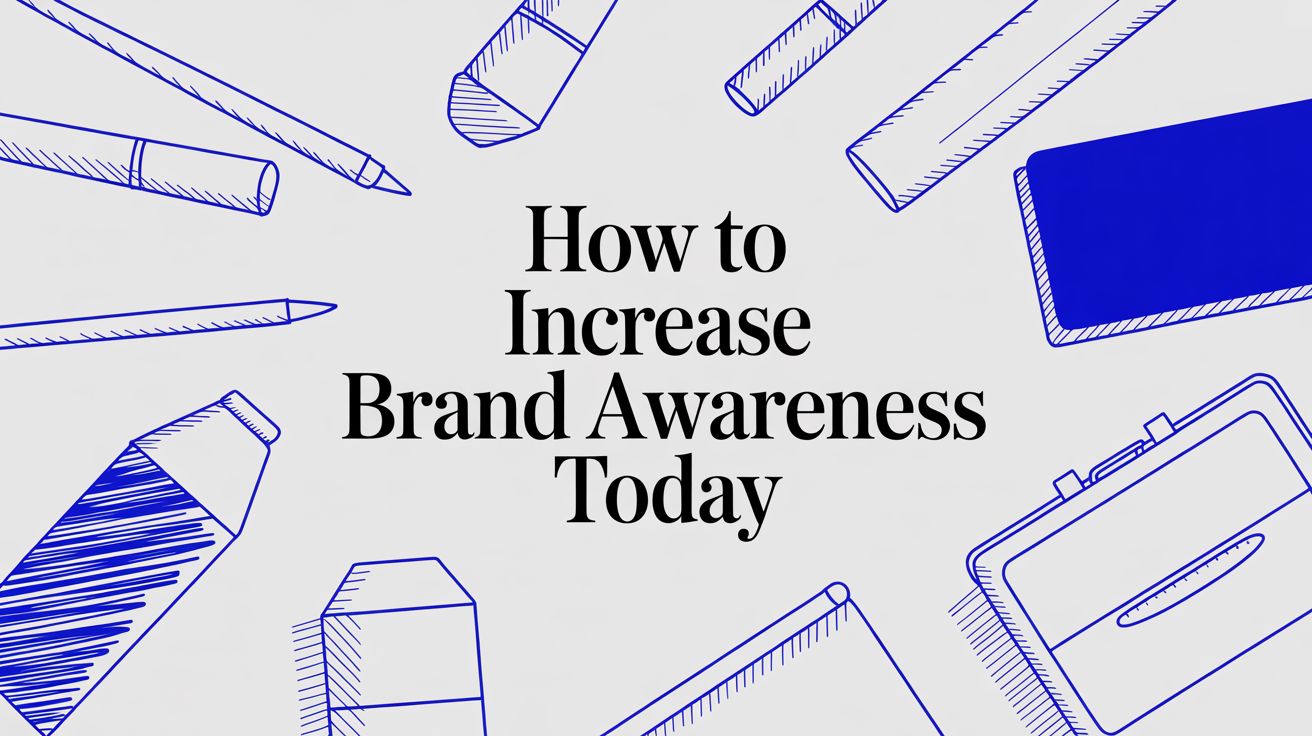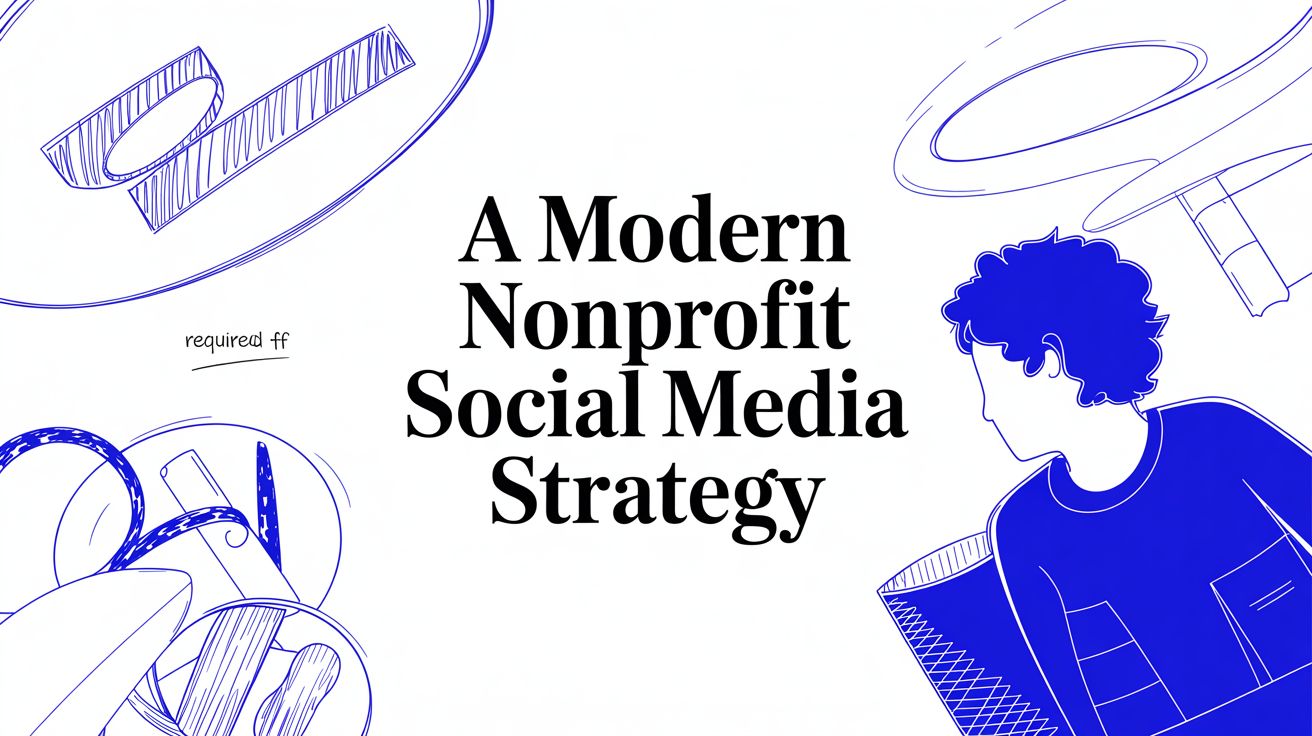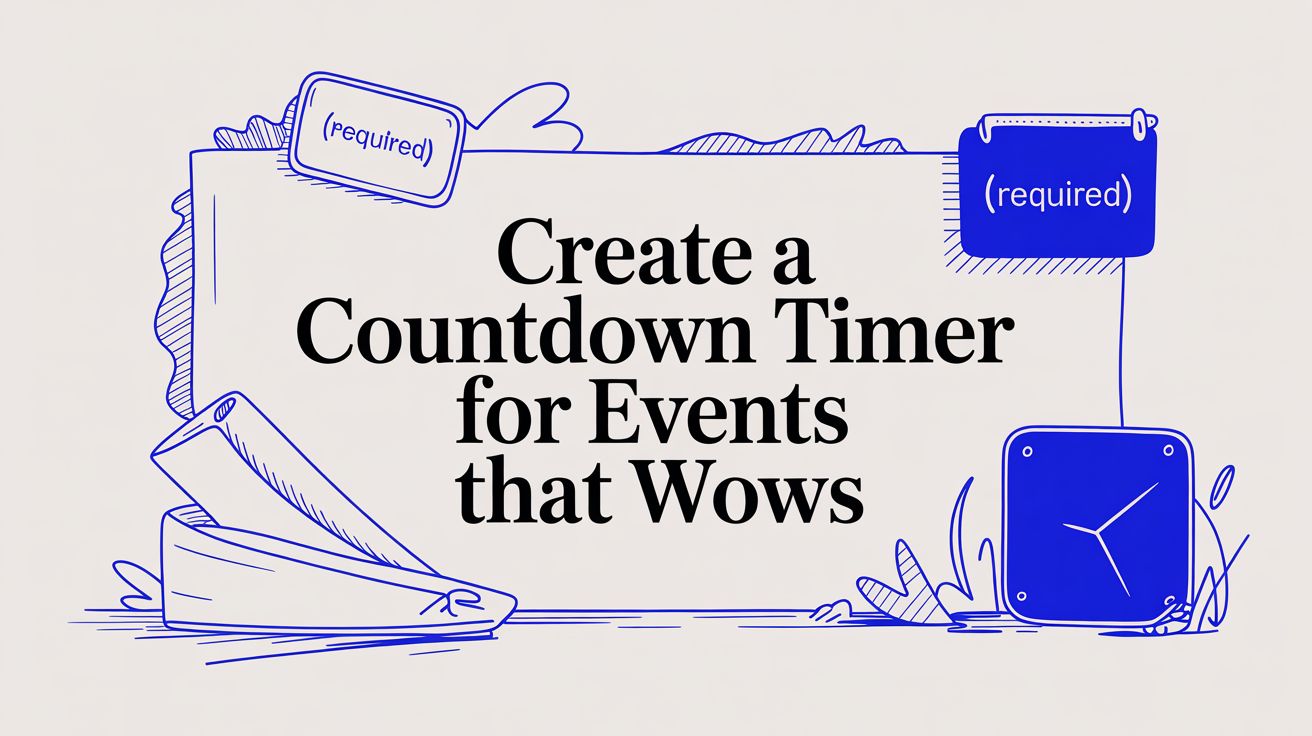Create Customizable Countdown Clocks That Convert
Learn how to design and publish customizable countdown clocks that drive urgency and boost engagement. A practical guide for websites and social media.
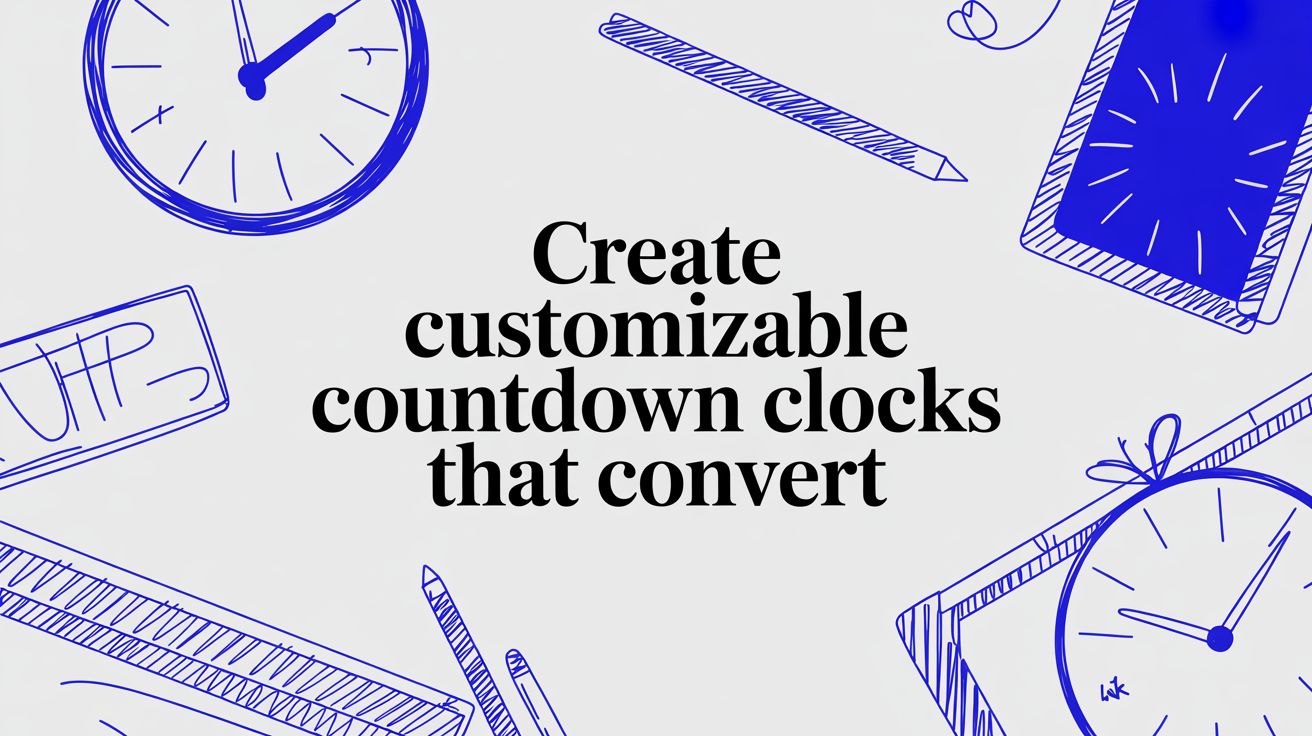
Ever wonder what makes you jump on a limited-time offer? More often than not, it's the simple power of urgency. This is where customizable countdown clocks come into play—they're the perfect tool to create that 'now-or-never' feeling. These timers tap directly into the natural 'Fear Of Missing Out' (FOMO), nudging people to act now instead of putting it off for later.
Why Countdown Clocks Are a Secret Marketing Weapon
A simple ticking clock can completely change how a visitor behaves on your site. When people see that time is running out, their brains flip a switch from passive browsing to active decision-making.
This isn't just some cheap gimmick; it's a direct application of powerful psychological principles like scarcity and loss aversion. The science is clear: people feel the pain of a loss much more intensely than the pleasure of a gain.
A well-placed countdown timer serves as a constant reminder that if they don't act, they're actively losing something valuable—a special discount, early access to a new product, or a limited-edition item. To see how these small but mighty tools fit into a larger picture, exploring effective content marketing strategies for small businesses can offer some great insights.
Beyond Generic Timers
The key to making this work is in the word "customizable." Let's be honest, a generic, out-of-the-box timer can feel clunky and even a little untrustworthy, potentially cheapening your brand's image.
But when a countdown clock seamlessly matches your website’s colors, fonts, and overall vibe, it becomes a natural part of the user experience.
This visual consistency is crucial for building trust and reinforcing your brand identity. Instead of looking like a random third-party plugin, it feels like a native, intentional element of your campaign. This small shift transforms the timer from a simple website gadget into a powerful conversion asset for things like:
- Product Launches: Build serious anticipation and create a hard deadline for early-bird pricing.
- Event Promotions: Drive ticket sales for webinars, conferences, or live streams by highlighting that time is running out.
- Flash Sales: Encourage immediate purchases during short-term promotional sprints.
A little-known fact is that the demand for this kind of personalization is exploding across all digital tools. The global smart alarm clock market, for instance, was valued at USD 0.77 billion in 2023 and is projected to grow at a staggering 26.0% CAGR through 2030, all fueled by consumer desire for custom features. This trend just underscores a broader shift toward personalized digital experiences.
The real magic of customizable countdown clocks isn't just about showing time; it's about creating an emotional response that perfectly aligns with a business goal. You're controlling the narrative and guiding your audience toward the exact action you want them to take.
We’ve seen firsthand how custom timers can inject a sense of energy and importance into any offer. Here's a quick look at why they're so effective.
How Custom Countdown Timers Drive Results
A quick look at the core advantages custom timers bring to your marketing and event strategies.
| Benefit | Psychological Impact | Business Outcome | | ------------------------ | -------------------------------------------------------- | ------------------------------------------ | | Increased Urgency | Triggers Fear Of Missing Out (FOMO) and loss aversion. | Higher conversion rates and faster sales. | | Enhanced Credibility | Seamless design builds trust and feels professional. | Stronger brand perception and loyalty. | | Improved Focus | Draws immediate attention to the call-to-action. | Lower bounce rates and increased clicks. | | Event Anticipation | Creates a shared sense of excitement and a focal point. | More sign-ups, ticket sales, and attendees.|
Ultimately, these timers are more than just a ticking clock; they are a strategic communication tool that can make a massive difference in turning hesitation into decisive action.
If you want to dig deeper into the psychology, you can learn more about how to create urgency in sales in our detailed guide.
Building Your First Timer Without The Headaches
Jumping into creating your first timer doesn't have to be a technical nightmare. With the right tool, you can skip the complicated stuff and focus on what really matters: your strategy. It all starts with picking a template that fits what you’re trying to do, whether that's a flash sale for your e-commerce store or building buzz for an upcoming webinar.
First things first, you'll need to select the end date and time for your countdown. A pro tip here is to pay close attention to time zones. Getting this wrong can cause a lot of confusion, especially if you have a global audience. Make sure it’s set correctly from the get-go.
If you're looking to build something slick without touching a line of code, you might want to explore no-code tools for creating interactive HTML5 content which can really cut down on development headaches.
With the timing locked in, you can start adding your own flair. This is where you make the timer feel like yours. Pick colors that match your brand’s palette and choose a font that screams your style. The goal is to make the timer look like a natural, integrated part of your website or social media, not some clunky, generic add-on.
Getting The Basics Right
Once you have your core elements in place—the template, timing, and initial branding—it’s time to give your project a clear name. Naming your timer something descriptive like "Black Friday 2024 Flash Sale" or "January Webinar Launch" will save you a ton of time later, especially when you're juggling multiple campaigns. It's a simple organizational step that sets you up for success.
This whole process is designed to guide a customer from just being aware of your offer to actually taking action. Think of it like this:
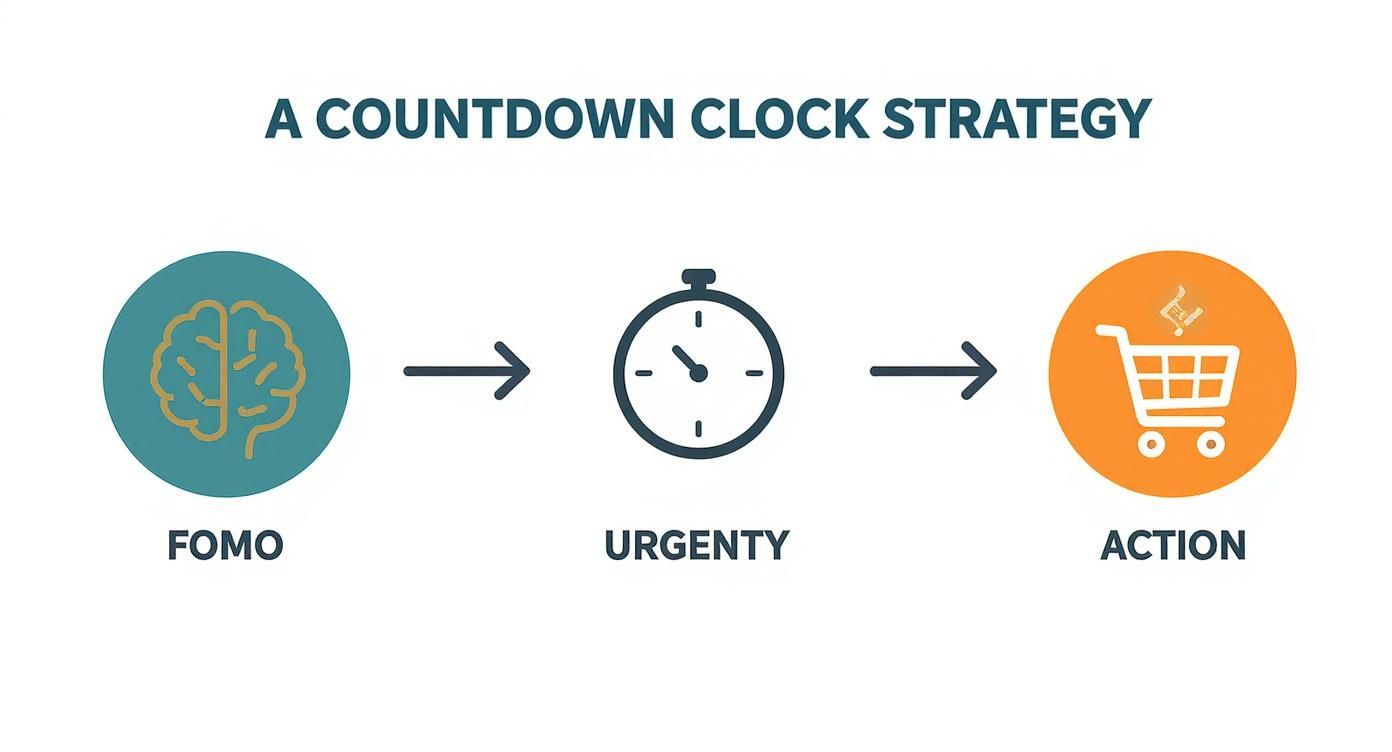
As you can see, the timer’s real job is psychological. It kicks off with a bit of FOMO, builds that crucial sense of urgency, and ultimately pushes people to make a purchase or sign up.
Customizing for Your Platform
Different platforms call for different tactics. A timer for your website might be styled one way, but a timer for a Facebook event needs its own approach to really grab attention and drive engagement. For a deeper dive into that, our guide on choosing the perfect event countdown app is packed with specialized tips just for social media.
The most effective countdowns are born from a simple, clear process. By focusing on one step at a time—template, timing, basic design, and naming—you build a solid foundation for a high-impact marketing tool.
Design Secrets That Make Your Timer Pop
Let’s be honest: a standard, out-of-the-box timer often gets completely ignored. Sure, it technically works, but it’s not going to inspire anyone to take action. To really grab someone's attention, you need to turn your clock from a simple widget into a can't-miss part of your brand. The real magic of customizable countdown clocks is making them feel like a natural extension of your campaign's visual story.
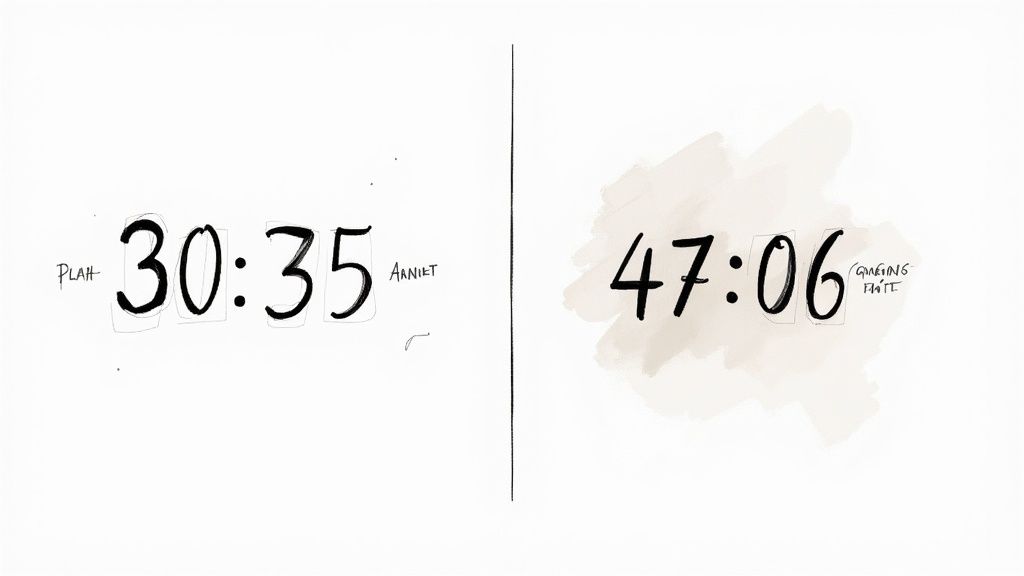
This is where smart design choices make all the difference. A well-designed timer doesn’t just look slick; it builds trust and makes your offer feel more professional and legit. You’re ditching the generic look and creating something that feels uniquely yours, which boosts credibility in an instant.
Think of it this way: a plain white timer on a beautifully designed sales page is like wearing running shoes with a tuxedo. It just looks out of place. The goal is to make every single element on your page work together to create a cohesive and persuasive experience.
Go Beyond Basic Colors
The first thing most people do is match the timer's colors to their brand palette, which is a great start. But you can push it so much further. One of the most powerful features at your fingertips is the ability to upload a custom background image.
Instead of a boring solid color, why not use a high-quality image of the product you’re launching? Or maybe a shot of your event speakers? This visual context immediately connects the ticking clock to the actual offer, making the whole thing feel more tangible and desirable.
For instance, a boutique launching a new clothing line could use a stylish lifestyle photo of the collection as the timer's background. This not only looks fantastic but also reinforces what customers are about to get their hands on—or miss out on.
Master Typography and Readability
Your font choice says a lot about your brand. Are you modern and sleek, or classic and trustworthy? Picking a font that aligns with your brand identity is crucial for consistency. But remember, aesthetics should never come at the expense of readability.
A countdown clock’s primary job is to be understood in a split second. Always prioritize high-contrast color combinations between your text and the background. Black text on a white background is the gold standard for a reason, but other combos work great, too.
- Dark Backgrounds: Use white or a very light, bright color for the numbers.
- Light Backgrounds: Stick with black or a dark, saturated brand color.
- Image Backgrounds: This is a pro move. Consider adding a semi-transparent overlay (like a dark gray at 50% opacity) behind the numbers to make sure they pop, even against a busy image.
Pro Tip: Always, always check how your timer looks on both desktop and mobile. A design that’s perfectly clear on a big monitor can quickly become a jumbled, unreadable mess on a small phone screen. Responsive design isn’t just a nice-to-have; it’s essential for reaching your entire audience.
The Before and After Transformation
To really see the difference, just picture a basic timer: black numbers slapped on a plain white block. It works, I guess, but it’s totally forgettable.
Now, imagine the "after": the same timer, but this time it features your brand's unique font, a dynamic background image showing off your upcoming product, and colors that perfectly match your website's theme. The second version isn’t just a timer anymore; it’s a powerful piece of marketing that builds real excitement and drives conversions. This strategic attention to detail is what separates amateur promotions from professional campaigns that get results.
You've designed a killer on-brand timer, which is a fantastic start. But let's be real—it's not going to drive results until it's out there in front of your audience.
Getting your new marketing tool published is actually pretty straightforward. Whether you're aiming to light up your social media feed or boost website conversions, the key is grabbing the right link or code snippet for the job.
Think about where it'll make the biggest splash. For a flash sale, that might be a bold banner right at the top of your homepage. For an upcoming webinar, it could be a dynamic post pinned to your Facebook Page so nobody misses it.
Publishing on Your Facebook Page
Want to stop the scroll? Sharing a live, animated countdown directly on your Facebook Page is a surefire way to grab attention in a crowded newsfeed. Instead of just another static image, your followers will see a timer that’s actually ticking down, constantly reinforcing the urgency of your offer.
Inside the Countdown Timer App, just look for the "Share" option built for Facebook. This generates a special, shareable link. When you paste that link into a new Facebook post, the platform magically pulls in a preview of your live timer. All you have to do is add some compelling text, and you're good to go.
The real power here is visibility. Once posted, you can pin the countdown to the top of your page, ensuring it’s the first thing visitors see. This simple action keeps your event or sale top-of-mind for days or weeks.
Embedding on Your Website
If you're working with platforms like WordPress, Shopify, or Squarespace, embedding is the way to go. This method places the customizable countdown clock right into your site's code, making it a seamless part of the user experience. You'll just need to copy the HTML embed code provided by the app.
Once you've got the code, it's just a matter of pasting it in the right place. For a deep dive, check out our guide on how to embed a countdown timer in your website.
Here’s a quick rundown for popular platforms:
- WordPress: Just use a "Custom HTML" block in the editor and paste your code. Easy.
- Shopify: You can add it almost anywhere—a product description, a custom page, or even directly into your theme’s code by editing the Liquid files.
- Website Builders (Wix, Squarespace): Look for an "Embed," "HTML," or "Code" block. They all have one. Just drop your snippet in there.
The demand for these kinds of tools is exploding as everything moves online. The global timing devices market, which includes digital clocks, was valued at a massive USD 5.85 billion in 2023. It’s projected to hit nearly USD 9.68 billion by 2030, all driven by the need for precise timing in everything from our phones to 5G networks. You can dig into the full report on the timing devices market on GrandViewResearch.com.
If you publish your timer and something looks off, don't panic. The most common culprit is pasting the code into a visual editor instead of an HTML or code editor. Always double-check that you're in the correct mode so the code can render properly.
Creative Ways to Use Your Countdown Timer
So you've designed a slick-looking timer. That's a great start, but its real power comes from using it in clever ways. Moving beyond the basics can turn a simple clock into the engine of your marketing campaigns. Let's dig into some real-world scenarios where customizable countdown clocks can make a huge difference.
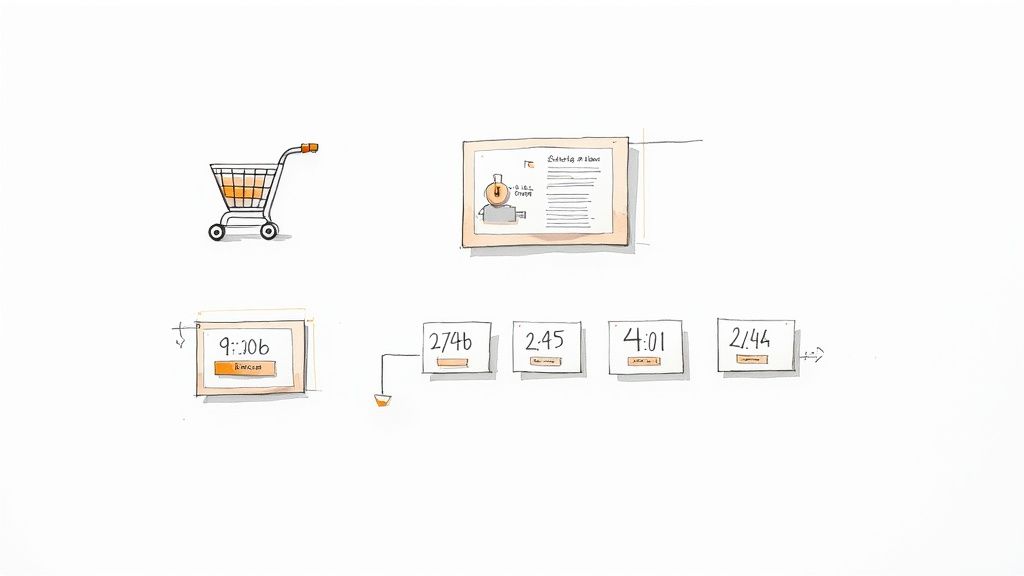
For anyone running an e-commerce store, the possibilities are practically endless. Think smaller and more frequent than just Black Friday. You can use timers to create a constant buzz that keeps your audience hooked.
- Flash Sales: Nothing drives a revenue spike like a 24-hour flash sale on a hot product category. The timer makes that offer feel exclusive and urgent.
- Holiday Promotions: Build anticipation for seasonal rushes like Valentine's Day or Mother's Day. Launch your campaign with a countdown to the moment the sale officially kicks off.
- Cart Abandonment: This one is surprisingly effective. Try dropping a timer in your cart abandonment emails. An offer like, "Complete your order in the next 3 hours for free shipping," can be just the nudge needed to recover a lost sale.
It's no surprise that the global digital timer market, which is closely tied to these clocks, was valued at USD 1.39 billion in 2024 and is on track to hit USD 2.23 billion by 2033. This growth is all about consumer demand for easy-to-use, programmable timers. You can check out more insights about the expanding digital timer market on BusinessResearchInsights.com.
Building Hype for Events and Launches
If you're an event marketer, a countdown timer is your absolute best friend. It's a visual anchor that builds genuine excitement for webinars, conferences, and live streams. When you share it regularly on social media, you create a steady drumbeat of anticipation that keeps your event top-of-mind.
Product launches also benefit hugely from a multi-stage countdown strategy. Instead of just one timer, think about using a series of them to tell a story.
- Phase 1 - The Teaser: Start with a timer counting down to the official product reveal.
- Phase 2 - The Early Bird: Follow up with another timer for a limited pre-order discount.
- Phase 3 - Launch Day: Finish strong with the final countdown to when the product is officially for sale.
This phased approach builds momentum and keeps your audience glued to every step of the journey.
Best Practices for Maximum Impact
How you manage your timer is just as important as where you put it. For Facebook posts, the update frequency is a crucial setting. I've found that setting it to update every 5 or 10 minutes strikes the perfect balance—it keeps the visual dynamic without causing any performance hiccups. For longer-term countdowns spanning several weeks, a slower interval like once an hour works great.
What happens when the clock hits zero? Don't just let it die. A great user experience means planning for what comes next. Set up your timer to automatically redirect visitors to the live sales page, the webinar waiting room, or even a "Sorry, you missed it!" page with a link to join your newsletter for future deals. This simple step ensures no click ever goes to waste.
Got Questions About Countdown Clocks? We've Got Answers.
Even with the best tools, you're bound to have questions when trying something new. And when it comes to customizable countdown clocks, a few of the same ones tend to pop up again and again. Let's tackle them head-on so you can get back to building buzz for your brand.
Answering the Tough Questions: Performance, Strategy, and More
One of the first things people ask is about authenticity. They’ll say, "Doesn't a countdown timer feel a little… fake?" The short answer? Only if you make it fake. Using a timer for a genuine deadline—like a real product restock or the last day for early-bird pricing—actually builds trust and credibility. It's the timers that never end or lead to nowhere that hurt your reputation.
Another big one is performance, especially on social media. People worry, "Will an auto-updating timer slow down my Facebook page or look glitchy?"
The good news is that modern countdown clock apps are designed to be incredibly lightweight. They don't run on your website or bog down Facebook's platform. Instead, all the heavy lifting happens on an external server, so your visitors won't notice any lag at all.
For Facebook specifically, the timer is just an image that gets refreshed on a schedule you set. It’s not some clunky script running in the background. That's why you can choose your update interval—from every five minutes to once a day—to get the perfect balance of dynamism and efficiency.
Here are a few other technical questions we hear all the time:
- What if I need to change the end date? No problem. A good tool lets you edit the end date, colors, or text whenever you want, even after the timer is live. It'll update automatically without you having to touch the post.
- Will it work on mobile? Absolutely. These timers are built to be fully responsive, so they look great and work perfectly on any screen, from a huge desktop monitor down to the smallest smartphone.
- Can I use a countdown clock in a Facebook Ad? Unfortunately, no. Facebook's ad policies don't support live, auto-updating elements like these. They're designed for your organic posts, where they can work their magic.
The bottom line is, you don't need to be a tech wizard to make these timers work for you. The whole process is designed to be simple, letting you focus on your marketing strategy instead of wrestling with code.
Getting Strategic With Your Countdown
Once the technical stuff is out of the way, the questions usually shift to strategy. For instance, "What's the best length for a countdown?" There's no magic number here; it really depends on what you’re promoting.
For a flash sale where you want to create a ton of energy fast, a timer of 24 hours or less is perfect. It screams "act now!" But if you're building up to a webinar or a major product launch, a longer countdown of 7 to 14 days is ideal. It gives you time to build anticipation and lets people work it into their schedules.
Whatever you do, make your timer impossible to ignore. Always put it right next to your main call-to-action—your "Shop Now" or "Register Here" button. That visual link between the ticking clock and the action you want them to take? That's what gets you conversions.
Ready to create a countdown that stops the scroll and gets people clicking? With the Countdown Timer App, you can build and publish a beautiful, on-brand timer for your website or Facebook Page in just a few minutes. Start creating your free countdown timer today.

